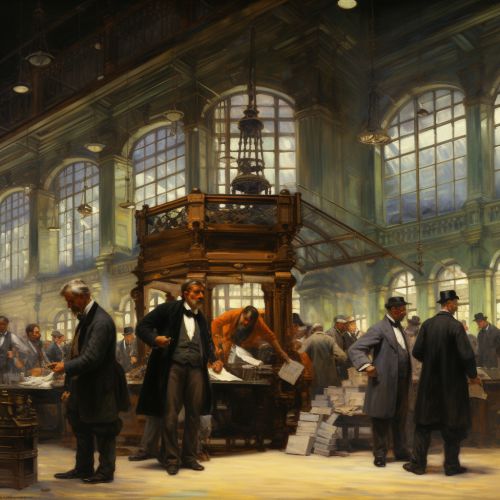Stock Market
Overview
The Stock Market is a public market for the trading of company stock and derivatives at an agreed price. These are securities listed on a stock exchange as well as those only traded privately. The stock market is one of the most vital components of a free-market economy, as it provides companies with access to capital in exchange for giving investors a slice of ownership in the company.
History
The concept of the stock market dates back to the 12th century, when French courratiers de change managed agricultural debts on behalf of banks. This was the first form of brokerage, though the concept of stocks and shares did not emerge until later. The first stock exchange was, inadvertently, a laboratory in which new human reactions were revealed. By the end of the 20th century, the stock market was a significant part of the global economy, with billions of dollars being traded daily.
Function
The primary function of a stock market is to bring buyers and sellers together and ensure fair dealing in securities transactions. It provides a platform where shares can be bought and sold. The stock market operates on the system of supply and demand. When a large number of people want to buy a certain stock, the price of that stock increases. If more people want to sell a stock than buy it, the stock price goes down.
Market Participants
Market participants include individual retail investors, institutional investors such as mutual funds, banks, insurance companies and hedge funds, and also publicly traded corporations trading in their own shares. Some studies have suggested that institutional investors and corporations trading in their own shares generally receive higher risk-adjusted returns than retail investors.
Types of Trading
There are two types of trading on the stock market: primary and secondary. In primary trading, companies sell new stocks and bonds to the public for the first time in an IPO. In secondary trading, investors buy and sell securities that were already issued in an IPO. Secondary trading takes place on the stock exchange.
Trading Mechanisms
Trading on the stock market is carried out by stock brokers, who are intermediaries between buyers and sellers. They use an electronic trading platform to buy and sell stocks on behalf of their clients. The trading process involves placing orders, which can be limit orders or market orders. A limit order is an order to buy or sell a stock at a specific price, while a market order is an order to buy or sell a stock at the best available price.
Market Trends
Stock market trends are described as a tendency of financial markets to move in a particular direction over time. These trends are classified as secular for long time frames, primary for medium time frames, and secondary for short time frames. Traders identify market trends using technical analysis, a framework which characterizes market trends as predictable price tendencies within the market when price reaches support and resistance levels, varying over time.
Risks Involved
Investing in the stock market carries risks, as the price of stocks can go down as well as up. Investors can lose some or all of the money they invest. The risk is higher with stocks than with other investments such as bonds or mutual funds. However, the potential for high returns also makes stocks attractive to investors.
Regulation
The stock market is regulated by government bodies that set rules and regulations to protect investors. In the United States, the SEC is responsible for enforcing securities laws. Other countries have their own regulatory bodies.
See Also


